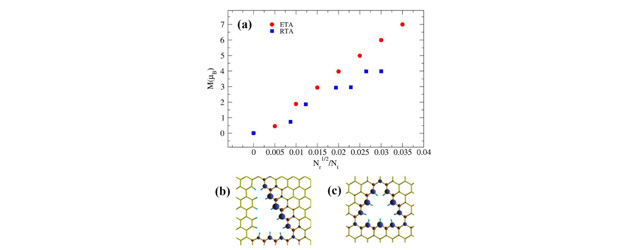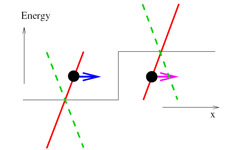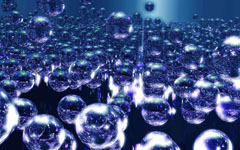
Highlights
2021

2020





2019





2018





2017





2016





2015





2014





2013






2012






2011






2010


Highway traffic fluctuations impact congestion durations (Vol. 48, No. 5-6)

Many highways around large cities are running above their capacity, leading to congested traffic. A useful statistical description of congestion distinguishes three phases: Free flow, synchronized traffic and wide moving jams. Traffic breakdown from free flow becomes increasingly likely around a critical flow (a certain number of vehicles per minute, specific for the highway section). Here we investigate the influence of flow fluctuations on congestion durations. As can be seen in the figure, traffic flow is antipersistent: It shows large fluctuations on short time scales which quickly trend back to the mean value, i. e. they reverse fast. Therefore, the duration of times with a flow above a critical value (here 60 vehicles per minute) is most oftenly a few minutes, but sometimes it extends over longer intervals up to several hours. We find that durations of congested traffic behave in the same way, and we conclude that traffic flow fluctuations are an important factor in congestion dynamics. The large number of short-lasting traffic jams implies a large risk for rear-end collisions.
S. M. Krause, L. Habel, Th. Guhr and M. Schreckenberg, The importance of antipersistence for traffic jams, EPL 118, 38005 (2017)
[Abstract]
Holey graphene as Holy Grail alternative to silicon chips (Vol. 50, No. 2)

Novel spintronics applications could stem from introducing holes into graphene to form triangular antidot lattices, granting the material new magnetic properties
Graphene, in its regular form, does not offer an alternative to silicon chips for applications in nanoelectronics. It is known for its energy band structure, which leaves no energy gap and no magnetic effects. Graphene antidot lattices, however, are a new type of graphene device that contain a periodic array of holes-- missing several atoms in the otherwise regular single layer of carbon atoms. This causes an energy band gap to open up around the baseline energy level of the material, effectively turning graphene into a semiconductor. In a new study published recently, Iranian physicists investigate the effect of antidot size on the electronic structure and magnetic properties of triangular antidots in graphene. The authors have confirmed the existence of a band gap opening in such antidot graphene lattices, which depends on the electron’s spin degree of freedom, and which could be exploited for applications like spin transistors.
Z. Talebi Esfahani, A. Saffarzadeh, and A. Akhound, A DFT study on the electronic and magnetic properties of triangular graphene antidot lattices, Eur. Phys. J. B 91, 308 (2018)
[Abstract]
How cells get a skeleton (Vol. 44 No. 5)
 Microscopy image of a cell.
Microscopy image of a cell.
Stress generated by nano-motors within animal cells can lead to the creation of a condensed layer of filaments beneath the outer cell membrane.
The authors have found that a well-defined layer beneath animal cells’ outer membrane forms beyond a certain critical level of stress generated by motor proteins within the cellular system. They have created hydrodynamic models of active gels to model the cell cortex. They first derived the equations providing a coarse-grained description of cortical dynamics, then calculated the configuration in which their model was in a steady state.
They found that for sufficiently high levels of contractile stress it consisted of a dense layer near the membrane, which abruptly cut off beyond a certain thickness. The key advance in their model is the inclusion of gel disassembly throughout the system, and the contractility due to molecular motors.
J.-F. Joanny, K. Kruse, J. Prost and S. Ramaswamy, ‘The actin cortex as an active wetting layer’, Eur. Phys. J. E 36, 52 (2013)
[Abstract]
How cooperation emerges in competing populations (Vol. 47 No. 5-6)

New theoretical approach to understand the dynamics of populations reaching consensus votes or of spreading epidemics
Social behaviour like reaching a consensus is a matter of cooperation. However, individuals in populations often spontaneously compete and only cooperate under certain conditions. These problems are so ubiquitous that physicists have now developed models to understand the underlying logic that drives competition. A new study published recently shows the dynamics of competing agents with an evolving tendency to collaborate that are linked through a network modelled as a disordered square lattice. These results are the work of the authors. They believe that their theoretical framework can be applied to many other problems related to understanding the dynamical processes in complex systems and networked populations, such as the voter dynamics involved in reaching a consensus and spreading dynamics in epidemic models and in social networks.
C. Xu, W. Zhang, P. Du, C.W. Choi and P.M. Hui, Understanding cooperative behavior in structurally disordered populations, Eur. Phys. J. B 89, 152 (2016)
[Abstract]
How do protein binding sites stay dry in water? (Vol. 42, No. 6)
What is the the condition for model cavity and tunnel structures resembling the binding sites of proteins to stay dry without losing their ability to react, a prerequisite for proteins to establish stable interactions with other proteins in water? To answer this, models of nanometric-scale hydrophobic cavities and tunnels are used to understand the influence of geometry on the ability of those structures to stay dry in solution. The authors study the filling tendency of cavities and tunnels carved in a system referred to as an alkane-like monolayer, chosen for its hydrophobic properties, to ensure that no factors other than geometrical constraints determine their ability to stay dry.
They show that the minimum size of hydrophobic cavities and tunnels that can be filled with water is in the nanometer range. Below that, the structure stays dry because it provides a geometric shield; if a water molecule was to penetrate the cavity it would pay an excessive energy cost to release its hydrogen bonds. By comparison, water fills carbon nanotubes that are twice smaller (but slightly less hydrophobic) than the alkane monolayer, making them less prone to stay dry.
It is also shown that the filling of nanometric cavities and tunnels with water is a dynamic process that goes from dry to wet over time. Water molecules inside the cavities or tunnels may arrange in a network of strong cooperative hydrogen bonds. Their disruption through thermal fluctuations induces the temporary drying of the holes until new bonds are re-established. Among many potential applications, one in biophysics would be to study water-exclusion sites of proteins, and understand the physical phenomenon linked to the geometry of those sites, underpinning the widespread biological process of protein-protein associations.
Behavior of water in contact with model hydrophobic cavities and tunnels and carbon nanotubes
E.P. Schulz, L.M. Alarcón and G.A. Appignanesi, Eur. Phys. J. E 34, 114 (2011)
[Abstract]
How hypergravity impacts electric arcs (Vol. 45 No.2)
 Glide arc discharge under normal gravity conditions.
Glide arc discharge under normal gravity conditions.Credit: J. Sperka et al.
A new study focused on electric discharge behaviour under intense gravitational forces shows that its dynamic changes as gravity increases.
Arc discharges are common in everyday conditions like welding or in lightning storms. But in altered gravity, not as much is known about their behaviour. For the first time, the authors studied the behaviour of a special type of arc discharge, so-called glide arc, in varying hypergravity conditions, up to 18 G. In this work they demonstrate how the plasma channel of this glide arc discharge moves due to external forces of buoyancy in varying gravity conditions. These results could have implications for improved safety precautions in manned space flights and in the design of ion thrusters used for spacecraft propulsion.
The authors performed measurements on atmospheric pressure glide arc helium plasma under the forces of hypergravity. They established a model showing that gravity strongly influences the glide arc discharge. These effects stem from thermal buoyancy, which increases with gravity, they conclude.
J. Sperka, P.Souček, J. J.W.A. Van Loon, A. Dowson, C. Schwarz, J. Krause, G. Kroesen and V.Kudrle, “Hypergravity Effects on Glide Arc Plasma”, Eur. Phys. J. D, 67, 261 (2013)
[Abstract]
How ion adsorption affects biological membranes’ functions (Vol. 50, No. 2)

A new study presents new models describing how the adsorption of calcium, barium and strontium ions onto biological membranes may affect the functions of cells
Ions with two positive electrical charges, such as calcium ions, play a key role in biological cell membranes. The adsorption of ions in solution onto the membrane surface is so significant that it affects the structural and functional properties of the biological cells. Specifically, ions interact with surface molecules such as a double layer of lipids, or liposomes, formed from phosphatidylcholines (PC). In a new study published recently, the author develops a mathematical model describing the electrical properties of biological membranes when ions such as calcium, barium and strontium adsorb onto them at different pH levels. Her work helps shed light on how ion adsorption reduces the effective surface concentration of add-on molecules with a specific function that can take part in biochemical reactions. These factors need to be taken into account when studying the diverse phenomena that occur at the lipid membrane in living cells, such as ion transport mechanisms.
I. Dobrzyńska, Association equilibria of divalent ions on the surface of liposomes formed from phosphatidylcholines, Eur. Phys. J. E 42, 3 (2019)
[Abstract]
How massless electrons tunnel through graphene (Vol. 43 No. 2)
 Klein tunnelling in one dimension. An electron incident from the left on a sharp potential step (the blue arrow indicates its direction of motion)
Klein tunnelling in one dimension. An electron incident from the left on a sharp potential step (the blue arrow indicates its direction of motion)
Electrons moving in graphene behave in an unusual way, as demonstrated by 2010 Nobel Prize laureates for physics A. Geim and K. Novoselov, who performed transport experiments on this one-carbon-atom-thick material. The present review explores the theoretical and experimental results to date of electrons tunnelling through energy barriers in graphene.
What could partly explain graphene's properties is that electrons travelling inside the material behave as if they were massless. Their behaviour is described by the so-called Dirac equation, which is normally used for high-energy particles such as neutrinos in vacuum moving at a velocity 300 times greater than that of electrons, nearing the speed of light.
In this review, the authors focus on the tunnelling effect occurring when Dirac electrons found in graphene are transmitted through different types of energy barriers. Contrary to the laws of classical mechanics, which govern larger scale particles that cannot cross energy barriers, electron tunnelling is possible in quantum mechanics - though only under restricted conditions, depending on the width and energy height of the barrier.
However, the Dirac electrons found in graphene can tunnel through energy barriers regardless of their width and energy height; a phenomenon called Klein tunnelling, described theoretically for 3D massive Dirac electrons by the Swedish physicist Oskar Klein in 1929. Graphene was the first material in which Klein tunnelling was observed experimentally, as massive Dirac electrons required energy barriers too large to be observed.
Klein tunnelling in graphene: optics with massless electrons
P.E. Allain and J.N. Fuchs, Eur. Phys. J. B 83, 301 (2011)
[Abstract]
How Ni-Ti nanoparticles go back to their memorised shape (Vol. 43 No. 1)
 Can metals remember their shape at nanoscale, too?
Can metals remember their shape at nanoscale, too?
Metallic alloys can be stretched or compressed in such a way that they stay deformed once the strain on the material has been released. Only shape memory alloys, however, can return to their original shape after being heated above a specific temperature. For the first time, the authors determine the absolute values of temperatures at which shape memory nanospheres start changing back to their memorised shape - undergoing so-called structural phase transition, which depends on the size of the particles. To achieve this result, they performed a computer simulation using nanoparticles with diameters between 4 and 17 nm made of an alloy of equal proportions of nickel and titanium.
Using a computerised method known as molecular dynamics simulation, it is possible to visualise the transformation process of the material during the transition. As the temperature increases, it is shown that the material's atomic-scale crystal structure shifts from a lower to a higher level of symmetry. The strong influence of the energy difference between the low- and high-symmetry structure at the surface of the nanoparticle, which differs from that in its interior, explains the transition.
Most of the prior work on shape memory materials was in macroscopic scale systems. Potential new applications include the creation of nanoswitches, where laser irradiation could heat up such shape memory material, triggering a change in its length that would, in turn, function as a switch.
Simulation of the thermally induced austenitic phase transition in NiTi nanoparticles
D. Mutter and P. Nielaba, Eur. Phys. J. B 84, 109 (2011)
[Abstract]
How proteins read meta DNA code (Vol. 44 No. 3)
 Schematic representation of the model
Schematic representation of the model
Scientists have for the first time accurately calculated the sliding mechanism for deciphering the second genetic code written within the DNA base pair sequence.
Three quarters of the DNA in evolved organisms is wrapped around proteins, forming the basic unit of DNA packaging called nucleosomes, like a thread around a spool. The problem lies in understanding how DNA can then be read by such proteins. In the present paper, the authors have created a model showing how proteins move along DNA.
A basic computer model of the nucleosome is developed, in which DNA is described by a sequence of rigid blocks representing the base pairs. The idea is that a small defect in the form of a missing or extra base pair enters the DNA section wrapped around a nucleosome. This defect can then diffuse through the wrapped DNA and once it leaves the other end of the wrapped section, the nucleosome moves by the extra or missing length that the defect carried with it.
This model supports the idea of a second genetic code, consisting of a mechanical code written down within the base pair sequence and multiplexed with the traditional genetic code.
A. Fathizadeh, A. Berdy Besya, Mo. Reza Ejtehadi and H. Schiessel, ‘Rigid body molecular dynamics of DNA inside a nucleosome’, Eur. Phys. J. E 36, 21 (2013)
[Abstract]
How red blood cells behave in crowded vessels (Vol. 50, No. 4)

A new model of red blood flowing through narrow capillaries shows that the cells change shape and alignment, allowing plasma to flow down the sides
Blood consists of a suspension of cells and other components in plasma, including red blood cells, which give it its red colour. When blood flows through the narrowest vessels in the body, known as the capillaries, the interactions between the cells become much more important. In a new study published recently, a team of researchers has now developed a mathematical model of how red blood cells flow in narrow, crowded vessels. This could help design more precise methods for intravenous drug delivery, as well as 'microfluidic chips' incorporating artificial capillaries, which could offer faster, simpler and more precise blood-based diagnoses.
G. R. Lázaro, A. Hernandez-Machado and I. Pagonabarraga, Collective behavior of red blood cells in confined channels, Eur. Phys. J. E 42, 46 (2019)
[Abstract]
How small does your rice pudding need to get when stirring jam into it? (Vol. 49, No. 1)

New study shows that two seemingly diverging theories of ever-increasing disorder, known as entropy, can be tested against each other experimentally in the smallest possible systems.
Have you ever tried turning the spoon back after stirring jam into a rice pudding? It never brings the jam back into the spoon. This ever-increasing disorder is linked to a notion called entropy. Entropy is of interest to physicists studying the evolution of systems made up of multiple identical elements, like gas. Yet, how the states in such systems should be counted is a bone of contention. The traditional view developed by one of the fathers of statistical mechanics, Ludwig Boltzmann — who worked on a very large number of elements — is opposed to the seemingly disjointed theoretical perspective of another founding scientists of the discipline, Willard Gibbs, who describes systems with a very small number of elements. In a new study published recently, the author demystifies this clash between theories by analysing the practical consequences of Gibbs’ definition in two systems of a well-defined size. He speculates about the possibility that, for certain quantities, the differences resulting from Boltzmann's and Gibbs' approach can be measured experimentally.
L. Ferrari, Comparing Boltzmann and Gibbs definitions of entropy in small systems, Eur. Phys. J. Plus, (2017)
[Abstract]
How supercooled water is prevented from turning into ice (Vol. 46 No. 4)

Calculating the energy barrier that keeps liquid water below zero from immediately turning into ice provides the key to understanding its ability to be compressed as temperature drops.
Water behaves in mysterious ways. Especially below zero, where it is dubbed supercooled water, before it turns into ice. Physicists have recently observed the spontaneous first steps of the ice formation process, as tiny crystal clusters as small as 15 molecules start to exhibit the recognisable structural pattern of crystalline ice. This is part of a new study, which shows that liquid water does not become completely unstable as it becomes supercooled, prior to turning into ice crystals. The team reached this conclusion by proving that an energy barrier for crystal formation exists throughout the region in which supercooled water’s compressibility continues to rise. Previous work argued that this barrier vanished as the liquid gets colder.
C. R. C. Buhariwalla, R. K. Bowles, I. Saika-Voivod, F. Sciortino and P. H. Poole, Free energy of formation of small ice nuclei near the Widom line in simulations of supercooled water, Eur. Phys. J. E, 38, 39 (2015)
[Abstract]
How theoretical particle physicists made history with the Standard Model (Vol. 49, No. 1)

The personal recollections of a physicist involved in developing a reference model in particle physics, called the Standard Model, particularly in Italy.
Understanding the Universe requires first understanding its building blocks, a field covered by particle physics. Over the years, an elegant model of particle physics, dubbed the Standard Model, has emerged as the main point of reference for describing the fundamental components of matter and their interactions. The Standard Model is not confined to particle physics; it also provides us a guide to understanding phenomena that take place in the Universe at large, down to the first moments of the Big Bang, and it sets the stage for a novel cosmic problem, namely the identification of dark matter. Placing the Standard Model in a historical context sheds valuable light on how the theory came to be. In a remarkable paper published recently, Luciano Maiani shares his personal recollections with Luisa Bonolis. During an interview recorded over several days in March 2016, Maiani outlines the role of those researchers who were instrumental in the evolution of theoretical particle physics in the years when the Standard Theory was developed.
L. Maiani and L. Bonolis, The Charm of Theoretical Physics (1958-1993) Oral History Interview, Eur. Phys. J. H, (2017)
[Abstract]
Subcategories
- Highlights
- Vol. 41 No. 6 - Highlights
- Vol. 42 No. 3 - Highlights
- Vol. 41 No. 5 - Highlights
- Vol. 42 No. 1 - Highlights
- Vol. 42 No. 2 - Highlights
- Vol. 42 No. 4 - Highlights
- Vol. 42 No. 5 - Highlights
- Vol. 43 No.2 - Highlights
- Vol. 42 No. 6 - Highlights
- Vol. 43 No.1 - Highlights
- Vol. 43 No.3 - Highlights
- Vol. 43 No.4 - Highlights
- Vol. 43 No.5 - Highlights
- Vol. 43 No.6 - Highlights
- Vol. 44 No.1 - Highlights
- Vol. 44 No.2 - Highlights
- Vol. 44 No.3 - Highlights
- Vol. 44 No.4 - Highlights
- Vol. 44 No.5 - Highlights
- Vol. 45 No.1 - Highlights
- Vol. 45 No.2 - Highlights
- Vol. 45 No.3 - Highlights
- Vol. 45 No.4 - Highlights
- Vol. 45 No.5-6 - Highlights
- Vol. 46 No.1 - Highlights
- Vol. 46 No.2 - Highlights
- Vol. 46 No.3 - Highlights
- Vol. 46 No.4 - Highlights
- Vol. 46 No.5-6 - Highlights
- Vol. 47 No.1 - Highlights
- Vol. 47 No.2 - Highlights
- Vol. 47 No.3 - Highlights
- Vol. 47 No.5-6 - Highlights
- Vol. 48 No. 1 - Highlights
- Vol. 48 No. 2 - Highlights
- Vol. 48 No. 3 - Highlights
- Vol. 48 No.4 - Highlights
- Vol. 48 No.5-6 - Highlights
- Vol. 49 No.1 - Highlights
- Vol. 49 No.2 - Highlights
- Vol. 49 No.3 - Highlights
- Vol. 49 No. 4 - Highlights
- Vol. 49 No. 5-6 - Highlights
- Vol. 50 No. 1 - Highlights
- Vol. 50 No. 2 - Highlights
- Vol. 50 No. 3 - Highlights
- Vol. 50 No. 4 - Highlights
- Vol. 50 No. 5-6 - Highlights
- Vol. 51 No. 1 - Highlights
- Vol. 51 No. 2 - Highlights
- Vol. 51 No. 3 - Highlights
- Vol. 51 No. 4 - Highlights
- Vol. 51 No. 5 - Highlights
- Vol. 52 No. 1 - Highlights








